|
[Front Page] [Features] [Departments] [SGAP Home Page] [Subscribe]

Evolution of the Myrtle Family in Australia
Dr Peter Wilson
The theory of continental drift holds that the locations of the continents that we see today have not always been so. This concept has been around for a long time (because of the fossil evidence and the similarity of floras) but there was no hard evidence of actual continental movement until this century.
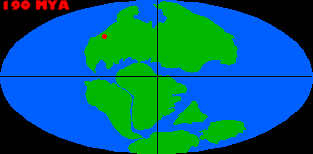
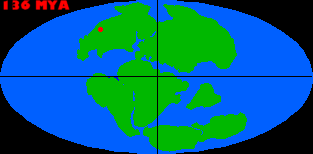
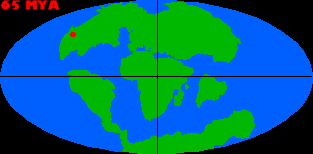
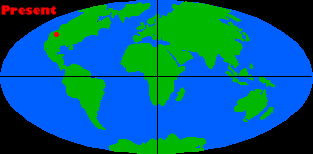 |
It is postulated that about 180 million years ago there were two large super continents, Laurasia in the north (Europe, North America and Greenland) and Gondwana in the south (Australia, Antarctica, South America, Africa, and India).
By 65 million years ago, Africa and India had separated from the other southern continents, the rapid movement of India northwards resulting in collision with Europe and Asia and producing the Himalayas.
Australia, Antarctica and South America maintained land links until about 49 million years ago. As might be expected, there are closer similarities between the floras of the three continents (in fossil form in Antarctica) than between the flora of Australia and Africa because of the longer period of separation in the latter case. For example, Australia and South America share several common genera (eg. Lomatia and Nothofagus, the Southern Beech) while floral relations between Australia and Africa only very rarely go below family level; one exception is the Boab, Adansonia.
As Australia severed its last link (with Antarctica) it began to drift north over a period of about 20 million years. The temperature then was decreasing and polar ice caps were forming. The Australian rainfall decreased and became more like it is now (ie. coastal rainfall and a drier interior). The climate became increasingly seasonal rather than continuously favourable.
Source of Maps: Grand Canyon Explorer
© Bob Ribokas
|
The habitat was changing rapidly (in geological terms), plants being put under much pressure by the changes in climate. Some became extinct. Plants had to evolve rapidly if they were to cope. Relict species of the old Gondwanan flora became restricted to the cooler and moister areas (more like the ancient climatic conditions).
Eventually Australia came close to its present position near the island chains of Indonesia and New Guinea and flora could move to and from Asia via those islands (mostly tropical zone plants).
The Myrtaceae
The Myrtaceae (or Myrtle family) has about 160 genera and several thousand species. The family is relatively poorly represented in the Northern Hemisphere, except in Asia, and is a rather insignificant component in Africa.
The family has traditionally been divided into two main groups, fleshy fruited and dry fruited.
Myrtaceae with fleshy fruits (Sub-family Myrtoideae)
Central and South America have 46 genera, of which 45 are endemic. Africa has 2 genera, neither of which is endemic. In Australasia, Asia and India there are 26 genera, of which 2 are not endemic (being the same two found also in Africa ... Eugenia and Syzygium). There is 1 genus in the Mediterranean area. This is Myrtus, the common Myrtle, from which the family name is derived.
Almost all of the fleshy-fruited Myrtaceae grow in the better soils rather than the nutrient deficient ones that characterise most of Australia.
There are three major groups of fleshy-fruited Myrtaceae and it is now clear that these are not all closely related to each other. Their Australian representatives are: -
- Genera that are closely related to Myrtus, eg. Austromyrtus, Rhodomyrtus, Rhodamnia and Fenzlia. The last, which should now be called Lithomyrtus, is a very interesting plant because its fruit has a stone-like centre, which is very unusual in the Myrtaceae; it occurs in northern Australia.
- Eugenia. This genus and its relatives are predominantly restricted to central and southern America; Australia has only a single species of Eugenia (E.reinwardtiana) which is found in Queensland.
- Syzygium and the related genera Waterhousea and Acmena (the "Lilly-pilly"). Syzygium is mostly restricted to northern coastal rainforests and some have migrated from Asia and New Guinea. This group is now known to have arisen independently of the other fleshy-fruited genera.
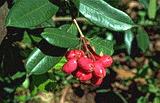 |
Syzygiums are popular in cultivation for their colourful, edible fruit. This is Syzygium australe.
Select the thumbnail image or plant name for a higher resolution image (28k). Photo: E.Anderson
|
An indication of the many different environments that members of the Myrtaceae have entered is shown by Osbornia, which is a mangrove. This is common on the landward side of mangrove areas in northern Australia.
Myrtaceae with dry fruits
a. Sub-family Leptospermoideae
Plants within this group are characterised by having a dry fruit in which the ovary is two or more locular (ie. split into two or more "compartments"...you can easily see these compartments if you examine a gum nut, for example).
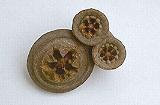 |
The compartments making up the ovary can be clearly seen in these eucalypt fruits The large fruit is that of Eucalyptus macrocarpa.
Select the thumbnail image or highlighted phrase for a higher resolution image (24k).
|
This group has the greatest number of species in the Myrtaceae. There are at least 70 genera in Australasia, Oceania and East Asia (Australia, north to Thailand, Burma and east to Hawaii). In South America, however, there is a single species (in Chile) and Africa is also poorly represented in the distribution with only two genera.
The group shows a good deal of evolutionary activity. Many have got out of the rainforest, though some need to be beside streams. Some species have evolved to inhabit dry heaths.
An example of a rainforest genus is Backhousia. There are 7 or 8 Backhousia species in Australia, all except B.myrtifolia occurring in rainforest. (B.myrtifolia can be found in wet sclerophyll forest and is common along the east coast from southern New South Wales to central Queensland).
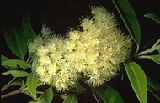 |
A distinctive feature of Backhousia citriodora is its strong lemon-scented foliage.
Select the thumbnail image or plant name for a higher resolution image (37k).
|
The genus Xanthostemon is characterised by a spherical, capsular fruit that splits to show a circle of flat seeds borne on the placenta. There are 14 species in Australia, 13 of which are endemic with the remaining species also being found in New Guinea. There are 19 species in New Caledonia and the genus also extends to Indonesia and the Philippines. Xanthostemon is an attractive genus having flowers with very showy stamens. The two most common species in cultivation are X.chrysanthus (yellow) and X.youngii (red).
Tristania is a genus which has seen some botanical revision in recent years. The most significant change was the re-naming of the "Brush Box" (formerly T.conferta; now Lophostemon confertus). In fact this species is more closely allied to Syncarpia (the "Turpentine") than to Tristania. L.confertus is well known as a street tree in many Australian cities and towns but it occurs naturally in areas marginal to rainforest, in wet sclerophyll forest and in drier rainforest. Another species is L.suaveolens (Swamp Mahogany) which occurs from Macksville to Cape York and New Guinea. Lophostemon has clearly spread out from rainforest into drier habitats.
Other changes in Tristania include the splitting off of Tristaniopsis. The Water Gum (formerly Tristania laurina) has become Tristaniopsis laurina; this is a common species in cultivation. Tristania neriifolia (which is well known and also, often referred to as the Water Gum) has remained in Tristania. It differs from T.laurina in its opposite leaves, different fruits and embryos.
 |
Tristania neriifolia can be found along creek banks in New South Wales.
Select the thumbnail image or plant name for a higher resolution image (33k).
|
The closest relative to Tristania is a true rainforest tree formerly known as Metrosideros queenslandica. However, this species has now been transferred to a new genus, Thaleropia, as there are no true Metrosideros on mainland Australia (two exist on Lord Howe Island).
Moving away from the rainforests it's impossible to ignore the eucalypts which are now regarded as comprising the genera Eucalyptus, Angophora and Corymbia. They occur mostly in open forest and woodland as dominants but have evolved to inhabit almost every conceivable habitat. E.torelliana even occurs in rainforest which is rare for a eucalypt and E. pauciflora grows in sunny alpine areas.
However, the eucalypts are not as successful as acacias in arid areas where they have a low species diversity and generally follow the creek lines (eg. E.camaldulensis, the river red gum). The eucalypts, together with many other plants native to fire-prone areas, have developed survival mechanisms to enable regeneration. In the dry areas particularly, the multi-stemmed mallee habit enables regrowth to occur from an underground lignotuber. Other adaptations to fire include thick woody fruits and epicormic buds below the bark, which sprout after fire has passed.
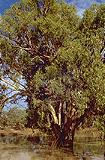 |
The river red gum, Eucalyptus camaldulensis (top), is restricted to creek beds in arid parts of Australia. Here it is seen during floods at Menindee Lakes in western New South Wales.
The curly mallee, Eucalyptus gillii (bottom), is found in dry, fire prone habitats in western New South Wales and (as here) in South Australia's Flinders Ranges.
Select a thumbnail image or plant name for a higher resolution image [57k and 54k].
|
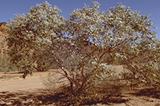 |
Another member of the Leptospermoideae that shows wide distribution is Melaleuca which is generally found in moister sites. Some occur in New Guinea and M.quinquenervia extends to New Caledonia. There is a great diversity of species in Western Australia in heathy areas.
Leptospermum is another widely distributed genus. The more primitive species extend into Asia, mostly on mountain tops.
b. Sub-family Chamelaucioideae
This last group has fruits which are one-locular and which don't dehisce (ie. seed is not shed from the capsule); it includes Thryptomene, Darwinia, Verticordia and Calytrix. This group is now known to have evolved from a Baeckea-like ancestor and does not merit sub-family ranking.
 |
Verticordia grandis is one of Australia's most spectacular wildflowers.
Select the thumbnail image or plant name for a higher resolution image (22k).
|
The group is most diversified in south-western Australia but some species do occur in other parts of Australia. For example, there are 44 (of about 77) species of Calytrix in the south-west of Western Australia with 14 endemic to the monsoon tropics and some others, including the widespread C.tetragona, found in the eastern states.
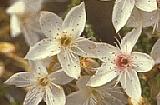 |
Although most species of Calytrix occur in Western Australia, Calytrix tetragona can be found in all Australian states except the Northern Territory.
Select the thumbnail image or plant name for a higher resolution image (30k).
|
The most highly evolved inflorescence in the Myrtaceae is that of Actinodium where the inflorescence mimics that of the Compositae (the daisies). This small genus is closely related to the Verticordia/Darwinia group and it completes the contrast between the different types of Myrtaceae...it seems the exact opposite to (say) Syzygium.
Concluding Remarks
The Myrtaceae is a very old plant family and has diversified significantly. An indication of the evolutionary history of the family can be seen from the fact that fossil pollen has been found in Antarctica. The Myrtaceae has evolved from the more primitive forms in moist, rainforest climates to the specialised forms in the very dry and highly seasonal western, semi-arid region.
This article is based on a lecture to the Australian Plants Society in May 1985. The Society would like to thank Peter for revising the article to reflect changes that have occurred since that time.
Dr Peter Wilson is a Senior Botanist at the Royal Botanic Gardens, Sydney.

[Front Page] [Features] [Departments] [SGAP Home Page] [Subscribe]
Australian Plants online - March 1999
The Society for Growing Australian Plants
|